INTRODUCTION
Over my four years on The Shield, I’ve always felt deeply connected to our online publications, The Shield Online and the @macjournalism Instagram account. Perhaps it’s a product of spending my entire first year as a staffer on Zoom. It’s no secret that I didn’t have the typical experience of most new staffers — seeing the paper arrive for the first time, staying after school for late nights or going to conventions. Because of this, I strived to find the value in other aspects of being on staff. For me, this meant figuring out how I could best serve our readers.
Over my time as a reporter, online-co-editor-in-chief and editor-in-chief, I believe that I have engaged our audience by creating content with multiple different media elements that elevated our work and better brought to life the stories of our school community.
WEB
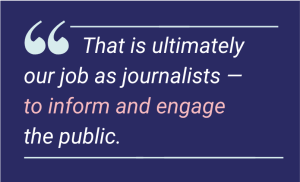 I joined The Shield, a primarily print-based staff, as the lone freshman with prior experience in broadcast journalism. I started off writing stories for our print issues and creating videos for our website. But quickly I realized that I could combine those two skills to help revamp our online presence and give our readers a deeper experience when using our website. From there I began writing stories with companion videos. Soon, I jumped to interactive online exclusives that utilized tools such as hyperlinks, slideshows and embedded content.
I joined The Shield, a primarily print-based staff, as the lone freshman with prior experience in broadcast journalism. I started off writing stories for our print issues and creating videos for our website. But quickly I realized that I could combine those two skills to help revamp our online presence and give our readers a deeper experience when using our website. From there I began writing stories with companion videos. Soon, I jumped to interactive online exclusives that utilized tools such as hyperlinks, slideshows and embedded content.
I enjoy multimedia journalism because it enhances the experience for an audience. That is ultimately our job as journalists — to inform and engage the public.
Creating engaging and interactive content
As I gained more familiarity with our website, I realized it needed to offer something different from our social media content and our newspaper. But there was a problem: most staffers viewed the website as secondary to print. This was because there was only so much story space in the paper, that it felt like an achievement when your story was selected. And since there’s space for every story on the website, a virtual byline felt less exciting.
I worked to set a new standard, by transforming my print stories to be more interactive and engaging when they went on the web. Scroll through and click the thumbnails to see some examples of my multimedia work.
Stepping up as leaders – Multimedia package
Originally I was assigned to cover girls basketball for a print, but after conducting the first round of interviews, I found a compelling story that I knew could be brought to life for an online audience. To fully understand just how committed this team was to supporting one another, our readers needed to see their interactions and hear their cheers — something that words alone could not convey. The multimedia package I created included an in-depth feature, a broadcast package and a photo gallery with captions from the season. I cross-promoted the multimedia content by adding a QR code to the web story and video package on the page design. Utilizing different multimedia tools allowed me to move away from focusing on one particular athlete or game, and instead showcasing the very best of team sports when players come together and support one another, allowing me to utilize technology to better engage readers.
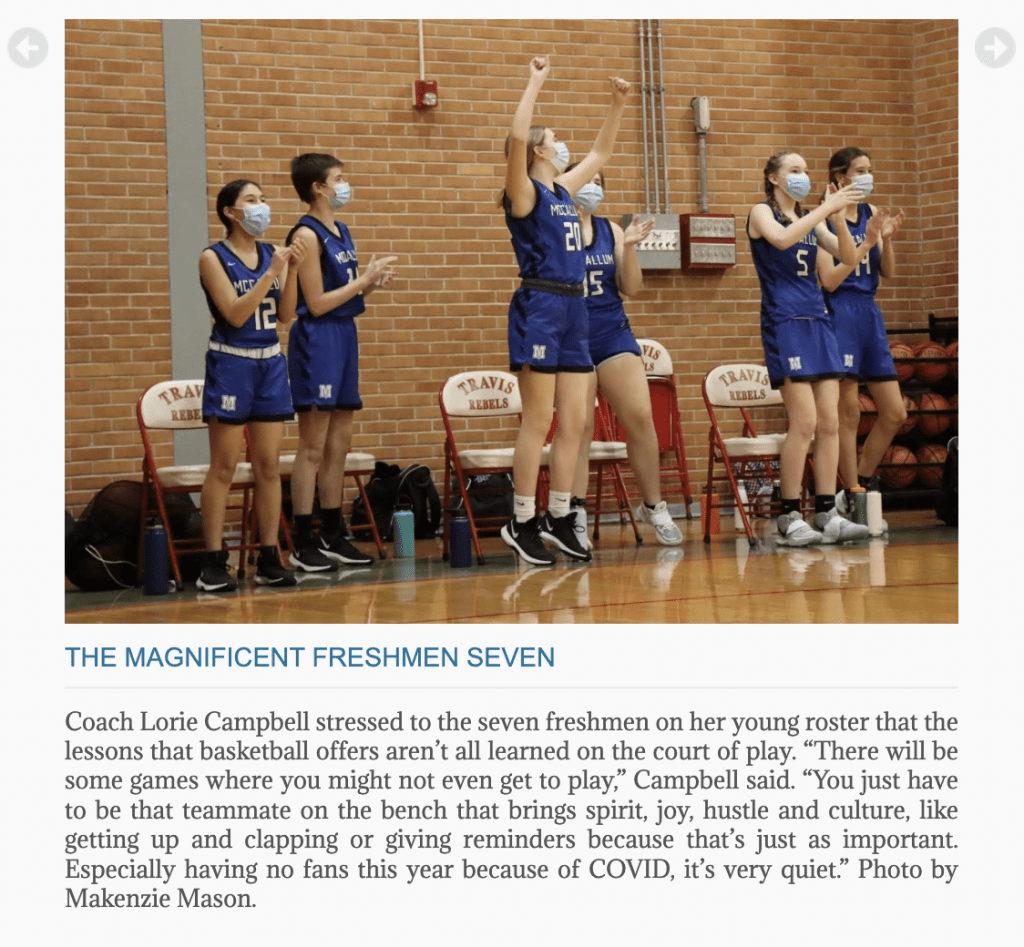
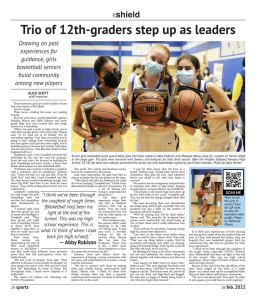
Recognitions: Fourth place – multimedia sports digital story of the year, NSPA Individual Awards (2021); Part of my Fourth place Multimedia Journalist of the Year portfolio, NSPA (2021)
Bend and snap - Interactive photo essay
After returning from my weekend documenting the commercial photography photo safari in Big Bend, I got to work writing a story about the trip to post on our website. But as I was drafting the article, I realized that I wouldn’t be telling the full story if I failed to showcase the student work created during the trip. I decided to take advantage of SNO’s flip card feature to showcase images I had taken of each student photographer that, when hovered over, flipped to show that student’s favorite photo that they had taken. Each flip card was included with an in-depth caption written from interviews with the student that detailed why their photo was so special and what they learned about on-site photography. This also allowed me to incorporate the perspective of all 12 students who went on the trip in an interactive way.
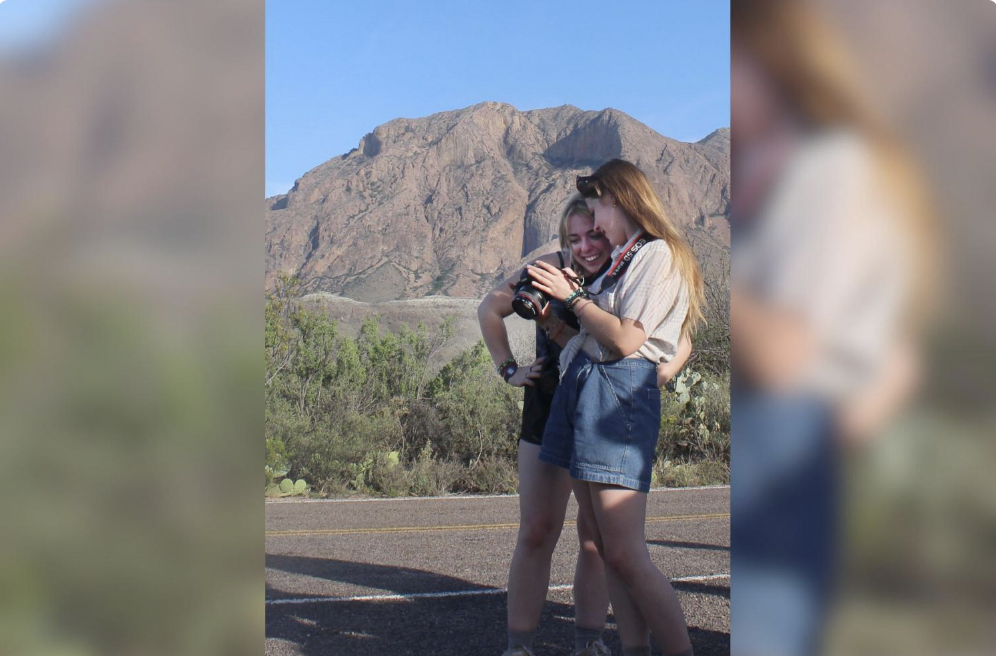
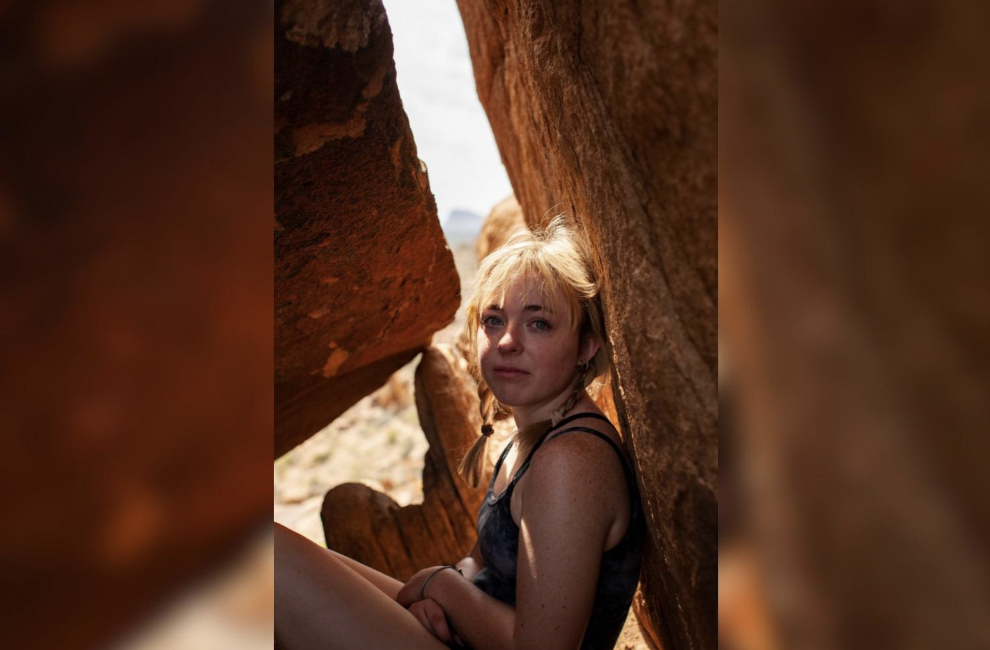
Recognitions: Honorable mention – interactive graphic of the year, NSPA (2023)
A COVID-19 year in the life at Mac – Multimedia package
The biggest story of the 2020-21 school year centered around the COVID-19 pandemic which became real for Austin citizens on March 12, 2020, when school was cancelled and the city was placed on lockdown. By weaving the interviews together to tell a shared narrative, this video package took the one-year anniversary as an opportunity to reflect upon a life-changing year through the eyes of McCallum students. As team leader for this project, I reviewed Flickr and Instagram to create a list of March 12, 2020 events that had stuck in students’ minds as the last “normal day” of school that could be included. I then organized interviews with sources who could speak to those events and reflect on the year that had passed. As writer, reporter and video editor, I paired the video with an article and photo gallery of March 12 and 13 events to show how the difference of one day in 2020 completely changed the goings-on in Austin.
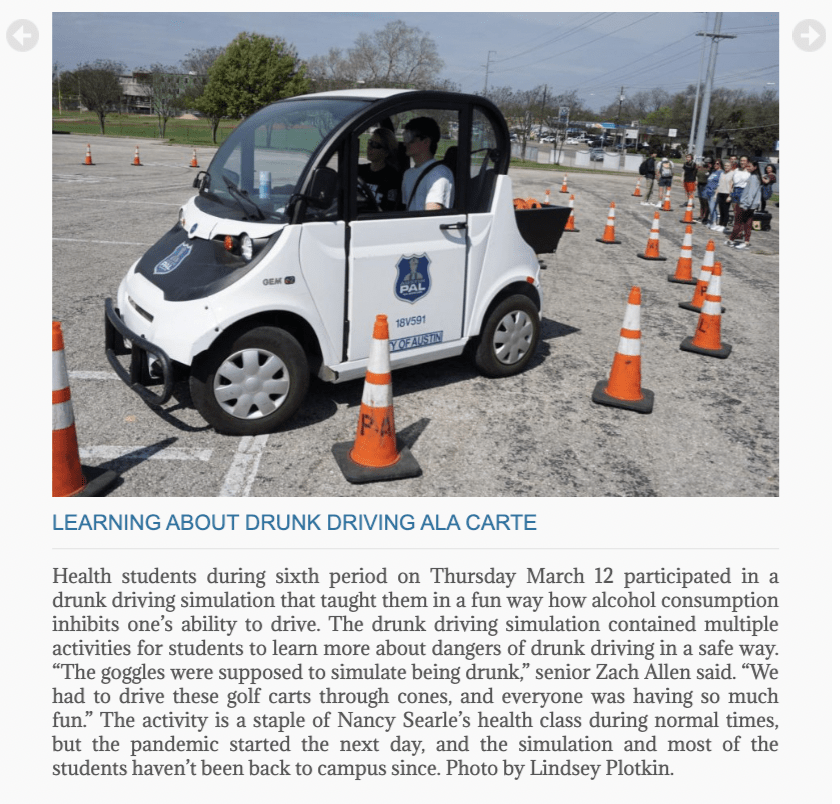
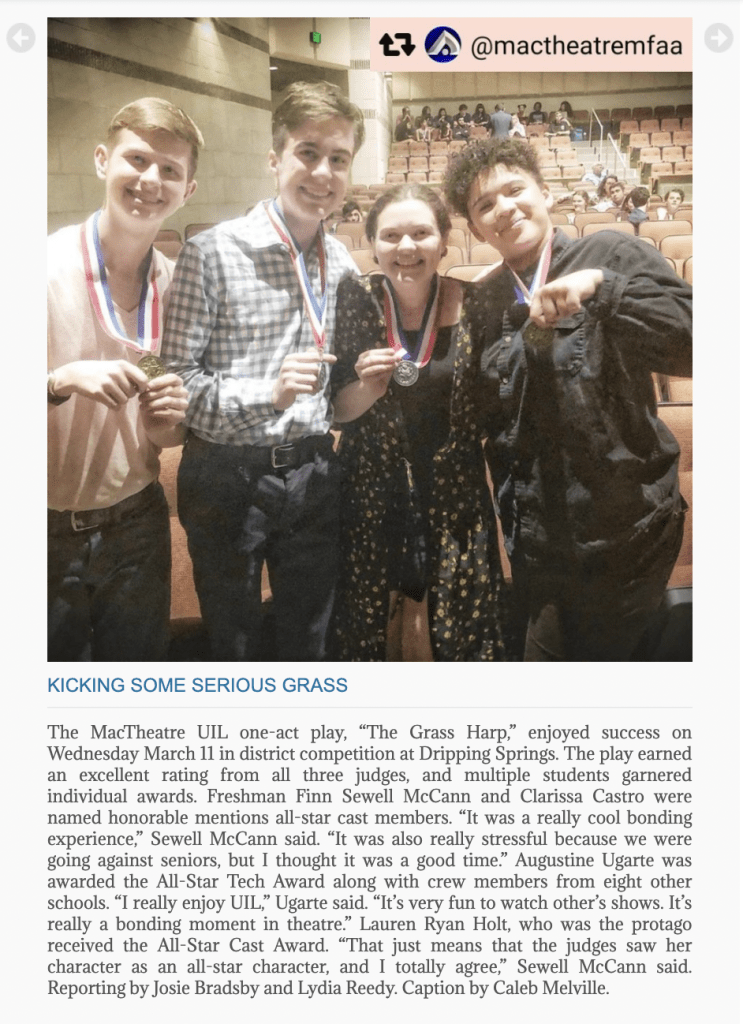
Recognitions: Second place – broadcast news COVID-19 reporting, NSPA Individual Awards (2021); Part of my fourth place Multimedia Journalist of the Year portfolio, NSPA (2021)
How did your legislators respond to Jan. 6 events? – Interactive breaking news package
As a high school journalism program, we often only learn about relevant breaking news when it has been covered by someone else. In an effort to get objective and reliable information out to our school community after the Capitol insurrection on Jan. 6, 2021, I streamlined localized information about Texas Legislators to provide students with credible facts about a complex and continually evolving story. I created an infographic to help more clearly convey information and wrote a complementary article that utilized hyperlinks and embedded content to allow readers draw their own conclusions about this historic event.

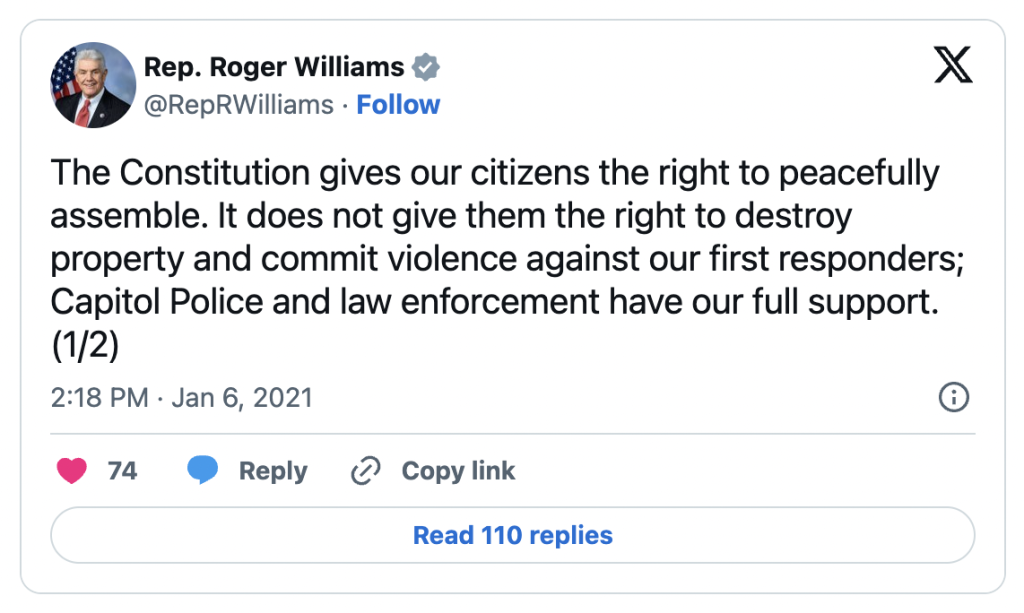
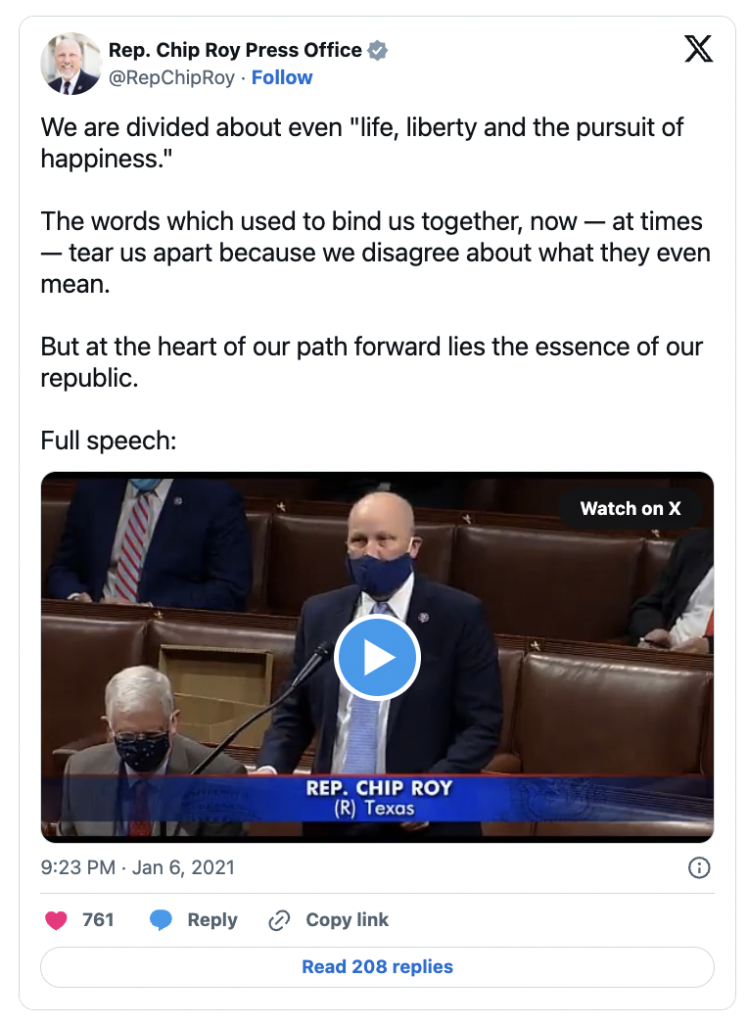
Recognitions: Part of my fourth place Multimedia Journalist of the Year portfolio, NSPA (2021)
Dear Mr. President and Madam Vice President – Multimedia package
When it came time to report on President Biden’s inauguration, I wanted to make coverage unique and local to McCallum — a somewhat difficult task when 75% of students could not vote in the election. At the same time I was working on this story, the Photojournalism class was working on letters to the incoming President about what they were hoping to see from the Biden-Harris administration. I decided to edit together the video letters to create an overarching narrative about student opinions about the direction of the country. I decided to pair the video with images of the actual letters to create an interactive web post with a diverse array of perspectives.
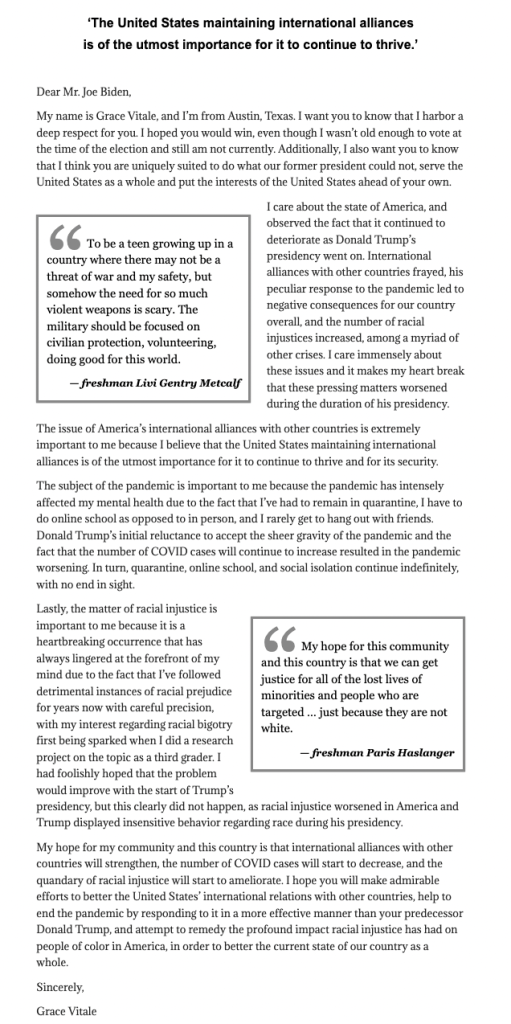
Recognitions: Honorable mention – broadcast commentary story of the year, NSPA (2021)
A Band-Aid for a bullet wound – Interactive graphic
Not all of my web stories are full-on multimedia projects. My main goal for the website was to make sure that it provides content in an alternate format from our print paper. This story was our issue 1 editorial, so when I created the draft for the website, I wanted to find a way to bring something new to an article most of our campus had already read.
Because much of my argument depended on statistics and information about the prevalence of school shootings in the U.S., I decided to turn that information into an interactive graphic that grabbed the reader’s attention. I used the website Data Gif Maker to create the chart to the right with statistics from Everytown for Gun Safety, to highlight just how prevalent school shootings have become.
The graphic was only a small addition to the web post, but it helped bring something new to the online story and improving engagement.
null
null
Website leadership & management
After my freshman year, my work on our website shifted from being a primary producer of online content to being a primary manager of online content. My sophomore year, I was selected as online-co-editor-in-chief, which put me in a position to help improve the quality of our website in a few ways.
First, as an online EIC, I oversaw the execution of recurring content like our Tuesday Top 10 photo essay or our Throwback Thursday articles. Second, I used my knowledge of broadcast and WordPress to teach staffers, even seniors who had been on staff longer than me, to incorporate multimedia elements into their usual stories. And third, I worked with co-online-EIC, Lucy Marco to schedule web critiques and study other award-winning online news sites to help improve the look of The Shield Online. In fact, we ended up redesigning the home page to modernize the site’s overall look and feel.
That spring, The Shield Online won the NSPA Pacemaker for online news sites after having not even been nominated the year before.
Even after I stepped into the role of editor-in-chief and focused more on the print edition, I always worked to ensure that the website received equal amounts of love. I created this “How to make a web draft” tutorial video to help streamline the process of getting our stories posted to the website.
The face of journalism is changing. Journalists like me need to be agile, creating content for online audiences, as the future of print media is unknown. At the moment on our campus, both mediums are important, but I also know it is essential to teach staffers about multimedia, so that the website, which may be the primary platform of The Shield in a few years, is in good hands after I graduate.
SOCIAL MEDIA
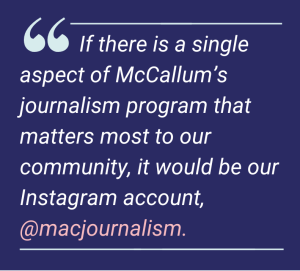 If there is a single aspect of McCallum’s journalism program that matters most to our community, it would be our Instagram account, @macjournalism. With over 6,200 followers, more than three times the size of the McCallum student body, MacJournalism has become a hub of information for students, teachers, parents and community members. When students are looking for the alternate schedule on pep rally days, they go to MacJournalism. When athletes want to see highlights from their most recent game, they go to MacJournalism. When parents are waiting to hear if AISD is going to cancel school for bad weather, they go to MacJournalism.
If there is a single aspect of McCallum’s journalism program that matters most to our community, it would be our Instagram account, @macjournalism. With over 6,200 followers, more than three times the size of the McCallum student body, MacJournalism has become a hub of information for students, teachers, parents and community members. When students are looking for the alternate schedule on pep rally days, they go to MacJournalism. When athletes want to see highlights from their most recent game, they go to MacJournalism. When parents are waiting to hear if AISD is going to cancel school for bad weather, they go to MacJournalism.
In fact, McCallum principal Andy Baxa even includes a message in almost all of his weekly email updates that reminds parents to follow MacJournalism for the most frequent updates regarding the goings-on at the school.
This is because MacJournalism has committed to holding our Instagram to the same standard of reporting as our print paper and our online news site, so much so, that we have posted to Instagram every school day for the past seven years. Our coverage of McCallum would not be complete without doing so.
Social Media Reporting
Most people, especially high schoolers, are not going to spend all their free time browsing The Shield Online or reading through our print edition. But it is a safe bet that they will spend free moments scrolling on Instagram. Because of this, we take a student-centered approach to coverage on Instagram, from sports to clubs to breaking news. This ensures that we engage our primary audience and get information out to them in the quickest way possible.
Live game coverage
This fall, I worked on the football coverage team where I photographed and reported on almost every varsity football game of the season. I was heavily involved in our live game coverage, which included quarterly posts with in-depth captions of the plays and halftime photo galleries. Live game coverage is a team effort and throughout the season I worked as a photographer, graphics editor and poster to get game updates out to our audience as soon as possible.
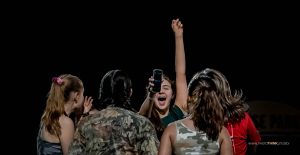
As a photographer my main priority was catching differentiated storytelling moments on the field. With a coverage team consisting of multiple photographers, I needed to prioritize getting unique shots. If the two other photographers were standing next to each other on the field, I would move to the end zone or switch to photographing cheer. This helped ensure our photo galleries showcased the many different moments of the quarter.
As the graphics maker I created the graphic templates in Adobe Express ahead of time, which included finding the right logo for the opposing team and verifying the details about the next football game for the final score graphic. During the game, I spent time on the sidelines with the poster toward the end of each quarter or game, to make sure our photos and graphics included accurate information.
As the poster I spent most of my time on the sidelines going through SD cards, editing the caption and cropping images as needed to make sure I executed each post before the start of the next quarter. It also meant I had the final say over any changes to our usual posting process. For example, I was the poster for McCallum’s homecoming game (see below), which meant that our usual halftime posting routine would be different because the band was performing before the game and the homecoming court announcement would take place during the halftime show. I also made the decision not to post a third-quarter update, because the score hadn’t changed and there was no new update to share with a quarterly recap.
Instagram will load in the frontend.
Instagram will load in the frontend.
Instagram will load in the frontend.
Instagram will load in the frontend.
Instagram will load in the frontend.
Instagram will load in the frontend.
Breaking news coverage
Breaking news is one of the most important aspects of our social media presence. With only six print issues a year and more limited engagement with our website, we rely on social media when there is information that needs to get out fast. My breaking news coverage has taught me to write on a deadline, think on my feet in evolving situations and find sources quickly and efficiently. The three posts below, which include coverage of AISD’s public meeting to discuss a possible TEA conservatorship, when theatre students missed their flight home due to chaos at the London Heathrow Airport or when McCallum’s COVID-19 testing site ran out of tests amidst the spread of Omicron, were all instances where social media reporting was critical to informing our community.
Instagram will load in the frontend.
Instagram will load in the frontend.
Instagram will load in the frontend.
Clubs and organizations coverage
One of the main reasons students like MacJournalism is because they get to see themselves and their friends represented in our coverage. Depending on how active certain clubs are, it can be challenging to ensure that they are well covered, especially if they do not meet regularly or only showcase their work a few times in the year. As opposed to sports which happen on a more regular schedule. I have worked to make sure my social media coverage of clubs and activities is just as comprehensive and robust as my coverage of athletics. By representing the diverse perspectives at my school, I have contributed to improved coverage that has made me an even better reporter and MacJ and even better publication.
Instagram will load in the frontend.
Instagram will load in the frontend.
Instagram will load in the frontend.
Mac senior wall
One of my favorite projects that The Shield takes on each spring semester is creating a virtual “senior wall” on Instagram. This tradition started in 2020 when the seniors didn’t get a proper send-off from high school due to the arrival of the COVID-19 pandemic. At the time, any senior who wished to be profiled for the virtual senior wall could DM MacJournalism and a reporter would reach out and interview them. This practice became so beloved by McCallum students, that we never stopped. What I like most about the senior wall posts is that they allow us to feature students from any club, organization or background regardless of what their future plans are – from college to trade school to a gap year. In my opinion, this is the best way that MacJ works to authentically and accurately represent our school community members. Below are a few of my favorite senior wall posts that I have written while on staff.
Instagram will load in the frontend.
Instagram will load in the frontend.
Instagram will load in the frontend.
Coverage of the AISD school board election
In the fall of 2022, the Austin Council of PTAs reached out to MacJournalism and asked us if we could be interested in doing a set of interviews with the two candidates running for the At-Large Position 9 seat on the AISD Board of Trustees. As the producer for this project, I helped determine questions to ask the candidates, filmed and edited the interviews. While the initial plan was to post the full videos of both interviews on The Shield Online, we realized we had a better opportunity to reach more people through social media. I had learned the success of Instagram Reels last year after utilizing them last year during my weeklong Student Press Freedom Week campaign (learn more about it in the Law, Ethics & News Literacy category), which influenced us to supplement the web interviews with Instagram content that broke down the answers of each candidate in shorter videos. These Reels put the candidate responses side-by-side which allowed our audience to come to their own conclusions about who was bet fit to serve our district in a more digestible way.
Analytics
Tracking website and social media engagements helps us gauge how effective we are at capturing the interest of our audience. By compiling analytics from 2023, we noted improvement in viewerships on The Shield Online as well as increases in followers on both Facebook and Instagram. Learn more about these metrics in the Marketing and Audience Engagement category or click to view this slideshow for a detailed analysis of our social and online growth.
Final thoughts
Through web and social media platforms, I was able to report news in different formats, growing my abilities, while also better providing information to my school. I learned to analyze the stories I had written or the topics I had been assigned for a way to make them more diverse in how they were presented. In an unusual four years, I found creative ways to conduct interviews — from Zoom to Instagram DM — troubleshooting and discovering the best ways to fill my stories with authentic student voices.
I gained knowledge of new technologies, like WordPress, to build a multimedia user experience for our online news site through feature profiles and breaking news. I gained a better understanding of how to provide objective information for an audience, by citing and hyperlinking sources to show authenticity as well as offer readers an opportunity to more deeply explore the facts surrounding a story.
I took photos, made videos, wrote articles and created infographics. I widened my ability to do what I love — telling stories — all while utilizing the best of various mediums in a way that allowed our readers to better connect with my storytelling.
Recognitions: Fourth place – Multimedia Journalist of the Year, NSPA Individual Awards (2021)


